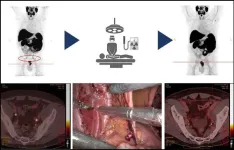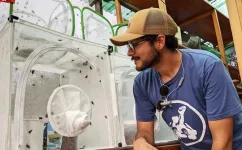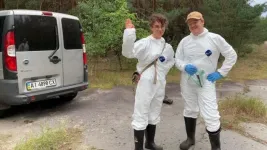(Press-News.org) A pedometer measures your steps, but what if you had a similar automated device to measure your eating behavior? Evidence from nutritional studies has long shown that the speed, timing and duration of an individual’s eating behavior are strongly related to obesity and other health issues. While eating behaviors can be accurately measured in a controlled laboratory setting, a blind spot exists when researchers attempt to study how participants actually eat “in the wild.”
A new National Institutes of Health-funded project by three scientists at the University of Rhode Island and The University of Texas at Austin aims to shed light on real-world eating behaviors, using AI-enabled wearable technology. The four-year, $2.4 million grant from the National Institute of Diabetes and Digestive and Kidney Diseases, supports the work of URI Nutrition Professor Kathleen Melanson and Psychology Professor Theodore Walls, and UT-Austin Electrical and Computer Engineering Professor Edison Thomaz.
They plan to develop a system to detect detailed information on eating motions, potentially every bite and chew. The researchers will combine more than 60 years of expertise in nutrition, behavioral statistics, and engineering to deploy a novel interdisciplinary project that would give researchers more complete data on study participants’ nutritional habits and behaviors.
“Eating behavior data collected in labs are most accurate, but people don’t live in labs, so we don’t know what they’re doing in real-world, day-to-day living,” Melanson said. “We want to compare the results from our new system to what we already have in the lab to ensure it is collecting data appropriately. The goal is to use this system in research so that we can test our interventions on modifications of ingestive behaviors.”
The study employs two devices: a typical smart watch and a discreet, custom-made sensor that sits on a participant’s jawline. The smart watch will capture the movement of arms and wrists when participants make typical eating gestures, measuring speed and frequency. It will be coupled with data captured by a small, button-sized sensor that will record jaw movements associated with chewing, recording the speed and intensity of the motion.
“The study moves through several successive experiments from an in-lab setting ‘into the wild,’ gradually moving from the internal validity of inferences in a lab-controlled setting to those grounded in the external validity of the real world," said Walls, whose research produces statistical tools to make sense of real-time intensive longitudinal health behavior data.
The researchers will study participants over the course of four progressive phases. After being fitted with the unobtrusive system, they will eat prescribed meals measured with standardized lab procedures and close supervision of the researchers. The next phase involves cafeteria-style eating, still under the close auspices of the researchers. The testing then moves into a restaurant setting where participants have more control over their meals. These phases will incrementally reflect more real-world eating conditions.
“We’re trying to answer, can you tell when someone is eating something? That might sound like a very simple question, but it turns out it’s very hard to do if you’re not in a very controlled setting,” said Thomaz. “When we talk, the jawbone definitely moves, but it doesn’t move in the rhythmic way it moves when you are chewing food. Those are the kinds of hints we’re going to try to leverage with sensors and AI algorithms. We will connect the two devices and see if we can come up with a more powerful system for detecting these kinds of eating behaviors.”
Finally, study participants return to their usual lives, but wearing the sensors to monitor their eating habits. Researchers will measure such data as the speed of eating, chewing and oral processing, how long food stays in mouth before swallowing, and how quickly the food disappears from their plates.
“With these kind of chewing and oral processing behaviors—rapid eating, taking large bites, not pausing between bites, and not chewing sufficiently—people might be over-ingesting calories before the satiety signals have time to develop,” Melanson said. “So, by assessing these behaviors, we can help develop a system that can be used in interventions to help people adapt their ingestive behaviors to maximize satiety and help with energy intake.”
Walls added that the study allows researchers to add other sensors, possibly one that monitors facial skin stretching. “We want to make sure we can make that progression out of the lab in a way that really works in an overall behavioral monitoring approach. Our ‘customers’ are people who want to start clinical trials using this system. This stage is just about the measurement, but later we will move on and test real programs to help people manage their eating behavior.”
Participants in the study will be those who would potentially benefit the most from it, those at risk for obesity-related harms. The researchers will recruit participants from the LatinX communities in both Rhode Island and Texas, enabling them to explore unique cultural food practices. Members of these communities experience higher prevalence of obesity and related health issues, on average.
Anyone interested in being a participant in the study can contact the researchers at: dibs@uri.edu.
END
Scientists to study real-world eating behaviors using wearable sensors and artificial intelligence
High-tech system development by University of Rhode Island, UT-Austin researchers measures real-world eating behavior, in and out of the lab
2024-03-05
ELSE PRESS RELEASES FROM THIS DATE:
Radioguided surgery accurately detects and removes metastatic lymph nodes in newly diagnosed prostate cancer patients
2024-03-05
Reston, VA — Radioguided surgery can detect and remove metastatic pelvic lymph nodes in patients newly diagnosed with prostate cancer, according to research published in the March issue of The Journal of Nuclear Medicine. Targeting the prostate-specific membrane antigen (PSMA), which is overexpressed in most prostate cancer patients, radioguided surgery can improve nodal staging to guide treatment recommendations for this important patient population.
In newly diagnosed prostate cancer patients, nodal involvement correlates with recurrence, and determining if lymph node metastases are present and where they ...
Aluminum nanoparticles make tunable green catalysts
2024-03-05
HOUSTON – (March 5, 2024) – Catalysts unlock pathways for chemical reactions to unfold at faster and more efficient rates, and the development of new catalytic technologies is a critical part of the green energy transition.
The Rice University lab of nanotechnology pioneer Naomi Halas has uncovered a transformative approach to harnessing the catalytic power of aluminum nanoparticles by annealing them in various gas atmospheres at high temperatures.
According to a study published in the Proceedings of the National Academy of Sciences, Rice ...
Electrolyte cation types control electrochemical reactions on an electrode surface
2024-03-05
1. An international research group consisting of NIMS and the Finnish University of Jyväskylä has discovered through its electrode-electrolyte system research that electron and proton (i.e., hydrogen ion) transfer mechanisms during oxygen reduction reactions (ORRs) on electrode surfaces vary depending on the types of cations dissolved in the electrolytic solution. These results suggest that the energy conversion efficiencies and selectivity of electrochemical systems (e.g., fuel cells and water electrolysis hydrogen production systems) can be improved by selecting optimal reaction pathways and that this could be achieved without using expensive electrode ...
The dangers of misaligned product co-development contracts—and how they can derail innovation in high-tech firms
2024-03-05
Researchers from Mansoura University and University of Guelph published a new Journal of Marketing study that examines how misaligned contracts can erode innovation outcomes of high-tech firms.
The study, forthcoming in the Journal of Marketing, is titled “Collaborating to Innovate: Balancing Strategy Dividend and Transactional Efficiencies” and is authored by Nehal Elhelaly and Sourav Ray.
When a giant multinational like Unilever partners with one of its major suppliers, such as the industrial enzyme-producer Novozyme, the collaboration can fast-track ...
New publication highlights urgency of parasitic wasp release to save native bird
2024-03-05
DENVER/March 5, 2024 – Researchers with the University of Minnesota, funded by Morris Animal Foundation, hope to release highly-specialized parasitic wasps to serve as a biological control method to save Darwin’s finches from a dire threat: the invasive avian vampire fly, Philornis downsi.
This species has been devastating finch populations on the Galapagos Islands by laying eggs in their nests, with the emerging larvae harming the nestlings.
To protect these iconic birds and other endemic species impacted by the fly, ...
Tiny worms tolerate chornobyl radiation
2024-03-05
The 1986 disaster at the Chornobyl nuclear power plant transformed the surrounding area into the most radioactive landscape on Earth. Humans were evacuated, but many plants and animals continue to live in the region, despite the high levels of radiation that persist nearly four decades later.
A new study led by researchers at New York University finds that exposure to chronic radiation from Chornobyl has not damaged the genomes of microscopic worms living there today—which doesn’t mean that the region is safe, the scientists caution, but suggests that these worms are exceptionally resilient.
In ...
Restoration of degraded areas in semi-arid region contributes to ‘return’ of soil microorganisms, study shows
2024-03-05
Strategies deployed for the restoration of degraded land have had promising results in Brazil’s semi-arid region, improving the microbial properties of the soil and contributing to a return of native ecosystem services. The techniques include removal of cattle or restriction of their access to specific areas of pasture; cultivation of cover crops; and terracing to control erosion. Recovery of soil microbial properties maintains biodiversity and raises crop yields, contributing to agricultural ...
New research details negative consumer impacts of BLM support on major companies and brands
2024-03-05
INFORMS Journal Marketing Science New Study Key Takeaways:
Brands that supported BLM on social media during the height of the movement suffered negative impacts on social media.
Negative impacts were felt from both Democratic and Republican consumers.
The ‘bandwagon effect’ was one of the more significant factors.
Some brands with more historical prosocial posting on social media and socially oriented missions suffer less from the negative effects and may even benefit from supporting ...
Having self-control leads to power
2024-03-05
Out-of-control behavior by CEOs and other powerful people constantly makes headlines – so much so that some might consider impulsivity a pathway to power. New research from the UC San Diego Rady School of Management and Texas A&M University finds that having self-control is often what leads to power.
In a paper published in the Journal of Personality and Social Psychology, researchers find that showing self-control influences how powerful an individual is perceived to be by their peers, as well as how much power they are granted by those peers. In a series of seven experiments with roughly 3,500 participants, both students ...
Endocrine Society elects Lange as 2025-2026 President
2024-03-05
WASHINGTON—Endocrine Society members elected Carol Lange, Ph.D., of the University of Minnesota in Minneapolis, Minn., as its 2025-2026 President. She will serve as President-Elect for a year beginning in June 2024 before becoming President in June 2025.
Lange is a Professor of Medicine and Molecular Pharmacology and Therapeutics, holds the Tickle Family Land Grant Endowed Chair of Breast Cancer Research, and is the Associate Director for Basic Science and the Director of the Molecular, Genetic, and Cellular Targets of Cancer Training Program at the University of Minnesota Masonic ...
LAST 30 PRESS RELEASES:
Decoupling the HOR enhancement on PtRu: Dynamically matching interfacial water to reaction coordinates
Sulfur isn’t poisonous when it synergistically acts with phosphine in olefins hydroformylation
URI researchers uncover molecular mechanisms behind speciation in corals
Chitin based carbon aerogel offers a cleaner way to store thermal energy
Tracing hidden sources of nitrate pollution in rapidly changing rural urban landscapes
Viruses on plastic pollution may quietly accelerate the spread of antibiotic resistance
Three UH Rainbow Babies & Children’s faculty elected to prestigious American Pediatric Society
Tunnel resilience models unveiled to aid post-earthquake recovery
Satellite communication systems: the future of 5G/6G connectivity
Space computing power networks: a new frontier for satellite technologies
Experiments advance potential of protein that makes hydrogen sulfide as a therapeutic target for Alzheimer’s disease
Examining private equity’s role in fertility care
Current Molecular Pharmacology achieves a landmark: real-time CiteScore advances to 7.2
Skeletal muscle epigenetic clocks developed using postmortem tissue from an Asian population
Estimating unemployment rates with social media data
Climate policies can backfire by eroding “green” values, study finds
Too much screen time too soon? A*STAR study links infant screen exposure to brain changes and teen anxiety
Global psychiatry mourns Professor Dan Stein, visionary who transformed mental health science across Africa and beyond
KIST develops eco-friendly palladium recovery technology to safeguard resource security
Statins significantly reduce mortality risk for adults with diabetes, regardless of cardiovascular risk
Brain immune cells may drive more damage in females than males with Alzheimer’s
Evidence-based recommendations empower clinicians to manage epilepsy in pregnancy
Fungus turns bark beetles’ defenses against them
There are new antivirals being tested for herpesviruses. Scientists now know how they work
CDI scientist, colleagues author review of global burden of fungus Candida auris
How does stroke influence speech comprehension?
B cells transiently unlock their plasticity, risking lymphoma development
Advanced AI dodel predicts spoken language outcomes in deaf children after cochlear implants
Multimodal imaging-based cerebral blood flow prediction model development in simulated microgravity
Accelerated streaming subgraph matching framework is faster, more robust, and scalable
[Press-News.org] Scientists to study real-world eating behaviors using wearable sensors and artificial intelligenceHigh-tech system development by University of Rhode Island, UT-Austin researchers measures real-world eating behavior, in and out of the lab





